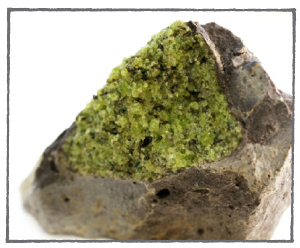PERIDOT

PERIDOT IS THE GREEN-HUED gem-quality variety of the mineral olivine. Olivine can also appear in yellow and golden tones—these gems are called chrysolite. Peridot has been mined for more than 3,500 years. The best deposits are located on St. John’s Island, in the Red Sea, in Pakistan, Brazil, Australia, Africa, and Arizona, and on the shores of Hawaii.
Because of their beautiful green hue, peridots were often confused with emeralds in ancient times. However, there is evidence that the stone was popular in its own right as well and was carved into beads by ancient Egyptians and was highly honored. It is believed that the pharaohs placed sentries to guard the peridot mines around the clock, and punishment for smuggling the stone was death. The stone was also a popular choice for signet rings of the time, and the pharaoh Ptolemy II commissioned a lifelike statue of his queen carved of peridot. (However, recent research suggests that the mineral was in fact green fluorite.) During the Middle Ages, the stone was thought to act as a powerful talisman against evil and demons and symbolized the sun. It was also used to counter nightmares and frighten away ghosts. There is some debate about the stone’s presence in Aaron’s Breastplate, as most references refer to chrysolite (the golden-colored variety of olivine), but of course, no one can be sure. Peridot also holds a place of honor in the Apache tribes of North America, and the tribes remain the sole landowner of one of the largest deposits in the world. Peridot also has the notoriety of being the only gemstone known to form on a planet other than Earth. It can be found in rare meteorites known as pallasites, and deposits were located on Mars in a 2003 expedition.
As a tool of “increase” in gem therapy, peridot is used to build wealth, health, emotional stability, and insight. It is thought to be the original birthstone for September and it is the modern birthstone for August. It is also linked to the sign Libra.